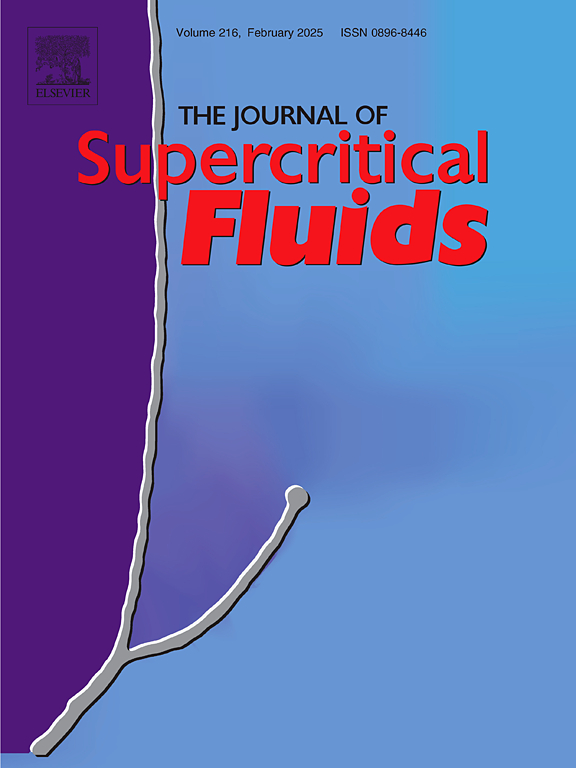不同稀释酸浸渍球磨竹的水解动力学及结构表征
IF 4.4
3区 工程技术
Q2 CHEMISTRY, PHYSICAL
引用次数: 0
摘要
研究了去离子水(B-ball)、H2SO4 (B-H2SO4)、HCl (B-HCl)和CH3COOH (B-CH3COOH)浸渍球磨竹在亚临界水中的水解机理。在酸相关机械铣削过程中,竹材会发生各种机械化学反应,导致溶解度提高,热稳定性和溶解度降低。酸相关机械处理对竹材在亚临界水中的水解行为也有显著影响。用Coats-Redfern方法可以很好地表达预处理竹的水解动力学。在球磨和亚临界水处理过程中,酸强度对竹材的水解起主导作用。H2SO4和HCl对糖苷键和纤维素-木质素化学键的解离能力最强。上述能力,连同他们的催化效应导致启动所需的活化能低的水解B-H2SO4(38.87 kJ 摩尔−1)和B-HCl(38.23 kJ 摩尔−1)相比生竹(74.34 kJ 摩尔−1)、篮球(104.42 kJ 摩尔−1)和B-CH3COOH(90.65 kJ 摩尔−1)在亚临界水中。综纤维素-木质素化学键的断裂使单体和可水解低聚物从综纤维素中缩聚得到葡萄糖炭和芳烃聚合物炭,从而提高了反应温度下固体残渣产率。促进了亚临界水水解过程中的糖苷键断裂和环断裂反应,提高了碳水化合物、5-羟甲基糠醛和糠醛的产率。本文章由计算机程序翻译,如有差异,请以英文原文为准。
Hydrolysis kinetics and structure characterization of ball milled bamboo impregnated with various diluted acids
The hydrolysis mechanism of ball milled bamboo impregnated with deionized water (B-ball), H2SO4 (B-H2SO4), HCl (B-HCl) and CH3COOH (B-CH3COOH) in subcritical water was investigated in the present study. Various mechanochemical reactions were induced during acid-associated mechanical milling and bamboo with improved solubility, reduced thermal stability and solubility was obtained. Acid-associated mechanical treatment also significantly affected the hydrolysis behavior of bamboo in subcritical water. The hydrolysis kinetics of pretreated bamboo could be well expressed by the Coats-Redfern method. The acid strength dominated the hydrolysis of bamboo during ball milling and subcritical water treatment. H2SO4 and HCl possessed the highest ability to dissociate the glycosidic bond and holocellulose-lignin chemical linkages. The above ability, together with their catalytic effects resulted in the lower activation energies required to initiate the hydrolysis of B-H2SO4 (38.87 kJ mol−1) and B-HCl (38.23 kJ mol−1) compared with those of raw bamboo (74.34 kJ mol−1), B-ball (104.42 kJ mol−1) and B-CH3COOH (90.65 kJ mol−1) in subcritical water. The cleavage of holocellulose-lignin chemical linkages liberated the polycondensation of monomer and hydrolysable oligomers from holocellulose for glucose char and aromatic-linked polymer char production, leading to the increase of solid residue yield at elevated reaction temperature. It also promoted the glycosidic bond cleavage and ring scission reactions during hydrolysis in subcritical water, resulting in the improved yields of carbohydrate, 5-hydroxymethylfurfural and furfural.
求助全文
通过发布文献求助,成功后即可免费获取论文全文。
去求助
来源期刊

Journal of Supercritical Fluids
工程技术-工程:化工
CiteScore
7.60
自引率
10.30%
发文量
236
审稿时长
56 days
期刊介绍:
The Journal of Supercritical Fluids is an international journal devoted to the fundamental and applied aspects of supercritical fluids and processes. Its aim is to provide a focused platform for academic and industrial researchers to report their findings and to have ready access to the advances in this rapidly growing field. Its coverage is multidisciplinary and includes both basic and applied topics.
Thermodynamics and phase equilibria, reaction kinetics and rate processes, thermal and transport properties, and all topics related to processing such as separations (extraction, fractionation, purification, chromatography) nucleation and impregnation are within the scope. Accounts of specific engineering applications such as those encountered in food, fuel, natural products, minerals, pharmaceuticals and polymer industries are included. Topics related to high pressure equipment design, analytical techniques, sensors, and process control methodologies are also within the scope of the journal.
 求助内容:
求助内容: 应助结果提醒方式:
应助结果提醒方式:


